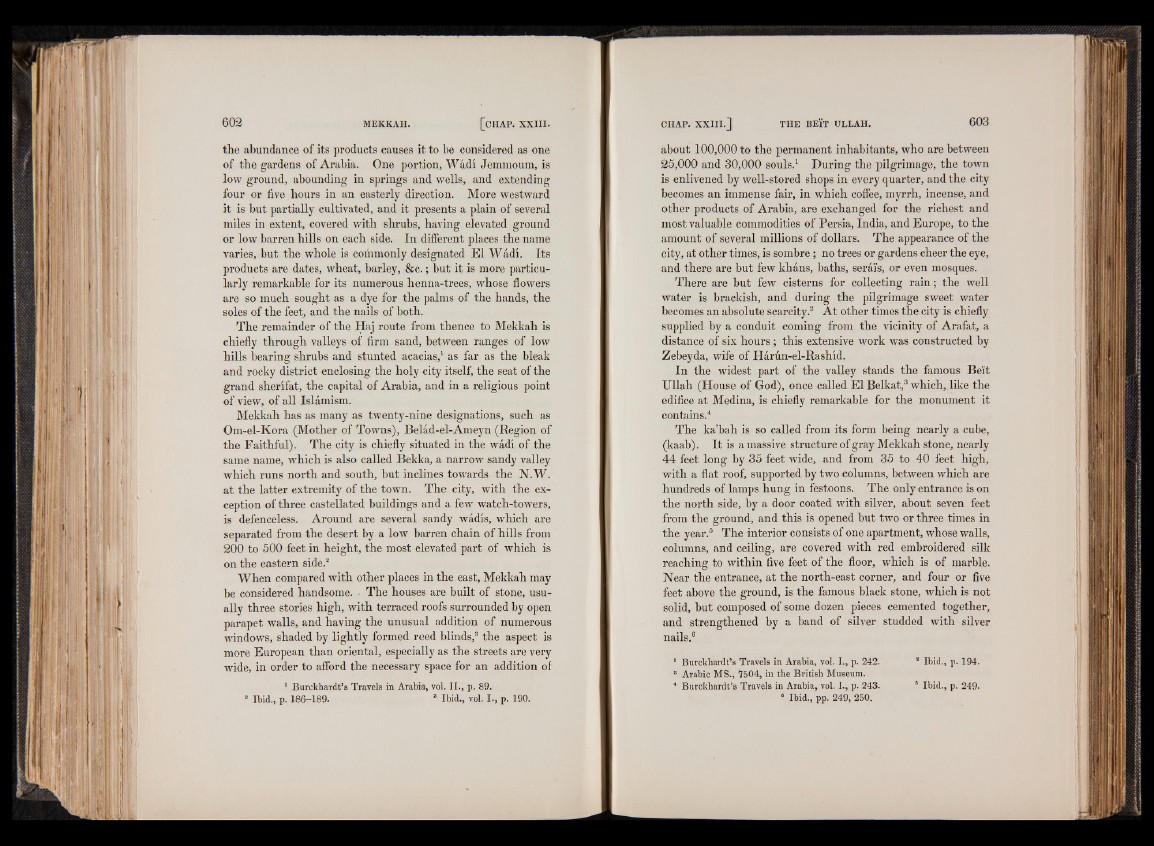
the abundance of its products causes it to be considered as one
of the gardens of Arabia. One portion, Wadi Jemmoum, is
low ground, abounding in springs and wells, and extending
four or five hours in an easterly direction. More westward
it is but partially cultivated, and it presents a plain of several
miles in extent, covered with shrubs, having elevated ground
or low barren hills on each side. In different places the name
varies, but the whole is commonly designated El Wadi. Its
products are dates, wheat, barley, &c .; but it is more particularly
remarkable for its numerous henna-trees, whose flowers
are so much sought as a dye for the palms of the hands, the
soles of the feet, and the nails of both.
The remainder of the Haj route from thence to Mekkah is
chiefly through valleys of firm sand, between ranges of low
hills bearing shrubs and stunted acacias,1 as far as the bleak
and rocky district enclosing the holy city itself, the seat of the
grand sherifat, the capital of Arabia, and in a religious point
of view, of all Islamism.
Mekkah has as many as twenty-nine designations, such as
Om-el-Kora (Mother of Towns), Belad-el-Ameyn (Region of
the Faithful). The city is chiefly situated in the wadi of the
same name, which is also called Bekka, a narrow sandy valley
which runs north and south, but inclines towards the N.W.
at the latter extremity of the town. The city, with the exception
of three castellated buildings and a few watch-towers,
is defenceless. Around are several sandy wadis, which are
separated from the desert by a low barren chain of hills from
200 to 500 feet in height, the most elevated part of which is
on the eastern side.2
When compared with other places in the east, Mekkah may
be considered handsome. • The houses are built of stone, usually
three stories high, with terraced roofs surrounded by open
parapet walls, and having the unusual addition of numerous
windows, shaded by lightly formed reed blinds,3 the aspect is
more European than oriental, especially as the streets are very
wide, in order to afford the necessary space for an addition of
about 100,000 to the permanent inhabitants, who are between
25,000 and 30,000 souls.1 During the pilgrimage, the town
is enlivened by well-stored shops in every quarter, and the city
becomes an immense fair, in which coffee, myrrh, incense, and
other products of Arabia, are exchanged for the richest and
most valuable commodities of Persia, India, and Europe, to the
amount of several millions of dollars. The appearance of the
city, at other times, is sombre; no trees or gardens cheer the eye,
and there are but few khans, baths, serais, or even mosques.
There are but few cisterns for collecting rain; the well
water is brackish, and during the pilgrimage sweet water
becomes an absolute scarcity.2 At other times the city is chiefly
supplied by a conduit coming from the vicinity of Arafat, a
distance of six hours; this extensive work was constructed by
Zebeyda, wife of Harun-el-Rashid.
In the widest part of the valley stands the famous Be'it
Ullah (House of God), once called El Belkat,3 which, like the
edifice at Medina, is chiefly remarkable for the monument it
contains.4
The ka’bah is so called from its form being nearly a cube,
(kaab). It is a massive structure of gray Mekkah stone, nearly
44 feet long by 35 feet wide, and from 35 to 40 feet high,
with a flat roof, supported by two columns, between which are
hundreds of lamps hung in festoons. The only entrance is on
the north side, by a door coated with silver, about seven feet
from the ground, and this is opened but two or three times in
the year.5 The interior consists of one apartment, whose walls,
columns, and ceiling, are covered with red embroidered silk
reaching to within five feet of the floor, which is of marble.
Near the entrance, at the north-east corner, and four or five
feet above the ground, is the famous black stone, which is not
solid, but composed of some dozen pieces cemented together,
and strengthened by a band of silver studded with silver
nails.6
' Burckhardt’s Travels in Arabia, vol. I., p. 242. 3 Ibid., p. 194.
3 Arabic MS., *7504, in the British Museum.
4 Burckhardt’s Travels in Arabia, vol. I., p. 243. 5 Ibid., p. 249.
6 Ibid., pp. 249, 250.